
ASL Signbank is a collection of ASL signs linked with ID glosses.
- Subject:
- Arts and Humanities
- Languages
- Material Type:
- Data Set
- Date Added:
- 01/04/2022

ASL Signbank is a collection of ASL signs linked with ID glosses.
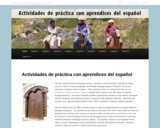
Actividades de práctica con aprendices del español is an online corpus of videos of second language and heritage language learners of Spanish during oral interviews and provides supplemental activities to help viewers investigate learners’ language and proficiency levels.
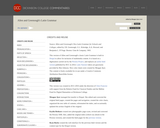
This version of Allen and Greenough's classic Latin Grammar is built in Drupal to allow for inclusion of multimedia content. It is based on a digitization carried out by the Perseus Project, and replaces an earlier html version published by DCC in 2014. Latin Tutorial videos are graciously provided by Ben Johnson. New color charts were created by Meagan Ayer. The content is freely available for re-use under a Creative Commons Attribution-ShareAlike license.

This American Sign Language 101 OER is a Google Doc containing instructional videos of original design. The document also offers media content from ASL instructors and creators across the Web. All materials are meant as a supplement to ASL instruction. These resources are in no way intended to replace the breadth of knowledge acquired from taking an ASL course.

This American Sign Language 102 OER is a Google Doc containing instructional videos of original design. The document also offers media content from ASL instructors and creators across the Web. All materials are meant as a supplement to ASL instruction. These resources are in no way intended to replace the breadth of knowledge acquired from taking an ASL course.
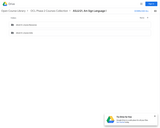
ASL I is an introduction to the naturally existing language widely used by Deaf people in North America. Since ASL is a visual-gestural language, students will need to develop unique communication skills. These consist of using the hands, body, face, eyes and space. In order to achieve progress in this class, it is important to become comfortable communicating with your whole body and listening with your eyes.
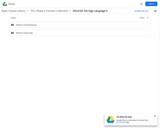
ASL II is a sequential course following ASL I, which continues to build knowledge of the naturally existing language widely used by Deaf people in North America. Since ASL is a visual-gestural language, students will need to continue to develop unique communication skills. These consist of using the hands, body, face, eyes and space. In order to achieve progress in this class, it is important to become comfortable communicating with your whole body and listening with your eyes.
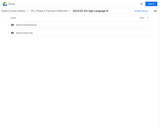
ASL III is the third quarter of the first year study of American Sign Language (ASL) and the people who use it. ASL III will enhance the use of ASL grammar and consist of concentrated efforts to develop the studentęs expressive and receptive skills. The course will continue to provide insights into Deaf Cultural values, attitudes and the Deaf community. Now learning more abstract concepts of the language, ASL III students will be able to: narrate events that occurred in the past, ask for solutions to everyday problems, tell about life events, and describe objects. Students will also be able to: demonstrate intermediate finger spelling competency, generate complex ASL structures with intermediate vocabulary knowledge, execute a wide variety of grammatical principles, including classifiers and inflections, adapt to different sign language registers, dialects and accents, and create opportunities to interact with members of the Deaf community.
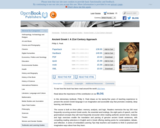
In this elementary textbook, Philip S. Peek draws on his twenty-five years of teaching experience to present the ancient Greek language in an imaginative and accessible way that promotes creativity, deep learning, and diversity. The course is built on three pillars: memory, analysis, and logic. Readers memorize the top 250 most frequently occurring ancient Greek words, the essential word endings, the eight parts of speech, and the grammatical concepts they will most frequently encounter when reading authentic ancient texts. Analysis and logic exercises enable the translation and parsing of genuine ancient Greek sentences, with compelling reading selections in English and in Greek offering starting points for contemplation, debate, and reflection. A series of embedded Learning Tips help teachers and students to think in practical and imaginative ways about how they learn. This combination of memory-based learning and concept- and skill-based learning gradually builds the confidence of the reader, teaching them how to learn by guiding them from a familiarity with the basics to proficiency in reading this beautiful language. Ancient Greek I: A 21st-Century Approach is written for high-school and university students, but is an instructive and rewarding text for anyone who wishes to learn ancient Greek.
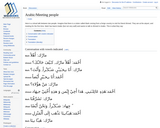
This webpage displays a common conversation between three friends. The structure and topics of the conversation are purposefully general so as to be helpful to students' ability to create and sustain conversations of their own. The conversation includes Arabic text, transliteration, and translation.
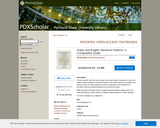
This text explores verb time, tense, aspect, and mood through comparison of Arabic and English sentence patterns. It includes examples of the Arabic patterns from classical and popular sources so Arabic students can learn by explanation and example how to formulate cohesive and grammatically correct sentence structure.
While this guide is intended mainly for English-speaking students studying Arabic, the charts also provide a quick reference of English sentence patterns for Arabic speakers.
The book is designed as a supplement.
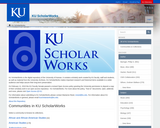
Au boulot! is a two-year college French program consisting of: a textbook, workbook and 21 accompanying audio exercises; as well as a reference grammar, to be used the entire two years. We also insist that our students obtain a full-sized dictionary, and we recommend the HARPER-COLLINS-ROBERT bilingual New Standard Edition. (Instructors will note in reviewing the materials that we provide vocabulary lists at the ends of chapters, with translations, but no glossary. We have become convinced after years of experience that glossaries are counter-productive. It is vital that students learn to use dictionaries, and the sooner the better.)
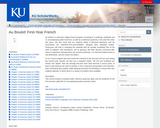
Au boulot! is a two-year college French program consisting of: a textbook, workbook and 21 accompanying audio exercises; as well as a reference grammar, to be used the entire two years. We also insist that our students obtain a full-sized dictionary, and we recommend the HARPER-COLLINS-ROBERT bilingual New Standard Edition. (Instructors will note in reviewing the materials that we provide vocabulary lists at the ends of chapters, with translations, but no glossary. We have become convinced after years of experience that glossaries are counter-productive. It is vital that students learn to use dictionaries, and the sooner the better.)

The book is titled "Basic English for Teaching Korean," and its primary audience consists of Korean teachers whose native language is not English and who plan to work in an English-speaking country. Given the increasing global demand for learning the Korean language, many individuals aspire to become Korean instructors. Among these future Korean educators, there are those who lack confidence in their English speaking skills and seek guidance on effectively teaching the Korean language using clear and fluent English. They are also interested in acquiring the appropriate terminology and expressions for conveying aspects of the Korean language and culture when instructing in the classroom. Within this book, we will offer a comprehensive, step-by-step guide on how to teach the Korean language in English.
"수업이 참 쉬워지는 한국어 교실 기초 영어"는 영어 실력이 부족하다고 느끼시거나 영어에 자신감이 없으 신 한국어 선생님들이 수업에 필요한 영어를 쉽게 익힐 수 있도록 구성한 책 입니다. 생소한 영어가 아닌, 우리가 알고 있는 영어를 최대한 활용 할 수 있도록 핵심적인 내용을 간결하게 담는 데 초점을 두었습니다. 책은 한 학기의 흐름에 맞추어 ‘수업 소개-수업 진행-수업 마무리’의 세 파트로 구분됩니다. 각 파트를 이루는 챕터들은 세부 상황으로 구 분하여 핵심 단어와 표현, 응용 문장과 대화를 수록했습니다. 설레는 학기의 시작부터 마음 따뜻해지는 학기 마무리까지 이 책 한 권으로 선생님들께 도움을 드릴 수 있다면 좋겠습니다.
Table of Contents:
들어가며
저자
목차
이 책의 특징
Part I: Class Orientation 수업 오리엔테이션
First Day of Class 첫 수업 시작하기
Class Introduction 수업 소개하기
Useful Expressions in Korean Class 수업 관련 유용한 표현 소개하기
Part II: Class Organization 수업 진행
Vocabulary 어휘 설명하기
Grammar 문법 설명하기
Speaking/Listening/Reading/Writing 말하기/듣기/읽기/쓰기 설명하기
Activity 활동 설명하기
Assignment & Next Class Notice 과제 및 다음 수업 안내하기
Part III: Class Wrap-up
Assessment 평가 설명하기
Feedback & Wrap-up 피드백 및 학기 수업 마무리하기
Appendix
Vocabulary 어휘 모아 보기
Expressions 표현 모아 보기

Short Description:
Basic Hindi is an online, interactive, theme-based textbook for the true beginner of Hindi language. It promotes communicative, linguistic, and cultural competence. It has mixture of pedagogical approaches to fit all types of learning and teaching philosophies/styles to achieve intermediate low to mid ACTFL proficiency level within a semester.
Long Description:
Basic Hindi is an online, interactive, and tech-enhanced textbook that promotes speaking, listening, reading, writing, and cultural skills. Each Chapter in this book has clear stated learning outcomes, a review of previous chapters, reading/listening sections, study abroad section, relevant grammatical items, and cultural notes. The pedagogical approach in the book is mixed and informed by the socio-cultural approaches and the generative approaches of the Second Language Acquisition theory. The mixed theoretical backgrounds match diverse learning and teaching philosophies and styles. Following the learning outcomes guided by American Council of Teaching Foreign Language (ACTFL), this textbook aims for the novice learners to attain intermediate low to mid-level proficiency level. The textbook incorporates pictures, audio-visual materials, and activities developed on the H5P platform to keep learners engaged.
Word Count: 40301
ISBN: 978-1-62610-105-0
(Note: This resource's metadata has been created automatically by reformatting and/or combining the information that the author initially provided as part of a bulk import process.)

Short Description:
This online interactive theme-based open textbook is for beginner learners of the Khmer language. This book aims to provide a practical introduction to speaking, listening, and reading. By the end of this course, students will be at the B1 level of the Common Framework for Language and at the low intermediate level on the American Council on the Teaching of Foreign Languages (ACTFL) proficiency scales. Basic Khmer is funded by the Open Educational Resources Program at Michigan State University.
Long Description:
This book contains eight chapters. In the first five chapters, each chapter is divided into two parts. The first part is based on the conversation and presents the grammar and vocabulary necessary to deal with everyday situations. The Cambodian script and sound system are introduced in the second part of each chapter.
Each chapter has clear learning outcome, a review of the previous chapter, the review of the vocabulary, grammar points and cultural notes. The layout of each chapter is followed by three modes of communication (interpretative, interpersonal and presentation mode) across the four skills. Each chapter also has a listening, speaking, reading and grammar section, followed by interactive activities. Cultural notes and a few online available materials related to the theme of the chapter is also introduced. Each chapter ends with key vocabulary/expression and Grammar summary. Vocabulary in reading and listening is built in the conversation with the English translation so that learners can infer the meaning in the given context. Learning activities have been developed by using h5p so that learners can get immediate constructive feedback.
Word Count: 14583
ISBN: 978-1-62610-118-0
(Note: This resource's metadata has been created automatically by reformatting and/or combining the information that the author initially provided as part of a bulk import process.)

Short Description:
Basic Urdu is a theme-based, interactive open-source online textbook for the true novice learners of the Urdu language. The book uses mixed pedagogical approaches to language teaching to match diverse teaching and learning styles. It aims to help learners achieve intermediate low to mid-proficiency levels set by the American Council on the Teaching of Foreign Languages (ACTFL).
Long Description:
Basic Urdu is a theme-based, interactive open-source online textbook for the true novice learners of the Urdu language. The book aims to help true novice learners of the Urdu language to achieve intermediate low to mid-level American Council on the Teaching of Foreign Languages (ACTFL) proficiency level. The book has eight chapters. Chapter 1 focuses on the Urdu script. Chapters 2 to 8 follow a similar pattern. They all begin with stated goals followed by three to four readings and listening, followed by grammar points. Reading and listening sections have the vocabulary, pre- and post-activities which follow a combination of pedagogical approaches to language teaching. It also has grammatical points so that users can build overall language proficiency inductively or deductively. Each chapter ends with cultural notes and extra online resources. The book has several interactive activities with in-built feedback for independent learners.
Word Count: 35406
ISBN: 978-1-62610-119-7
(Note: This resource's metadata has been created automatically by reformatting and/or combining the information that the author initially provided as part of a bulk import process.)
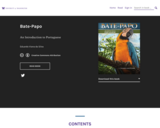
An Introduction to Portuguese
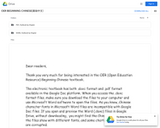
Textbook for a year-long Beginning Chinese course. Chapters are available in word and pdf files.
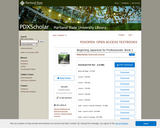
This textbook is designed for beginning learners who want to learn basic Japanese for the purpose of living and working in Japan. Unlike textbooks written primarily for students, whose content largely centers on student life, this book focuses more on social and professional life beyond school.
As a beginning level textbook, this book includes many elementary grammar patterns (Japanese Language Proficiency Test Levels 5 and 4), but the vocabulary and situations are selected specifically for working adults. Explanations are kept concise so as to only cover key points. The main focus is on oral communication and the accompanying audio is to be used extensively. This textbook can be used for self-study, as part of an online course, or as a traditional college course.